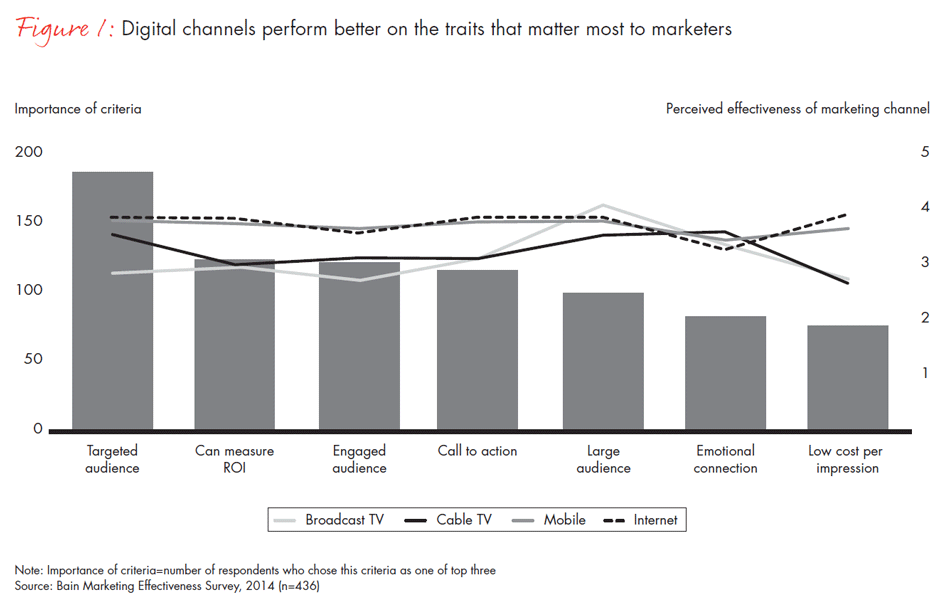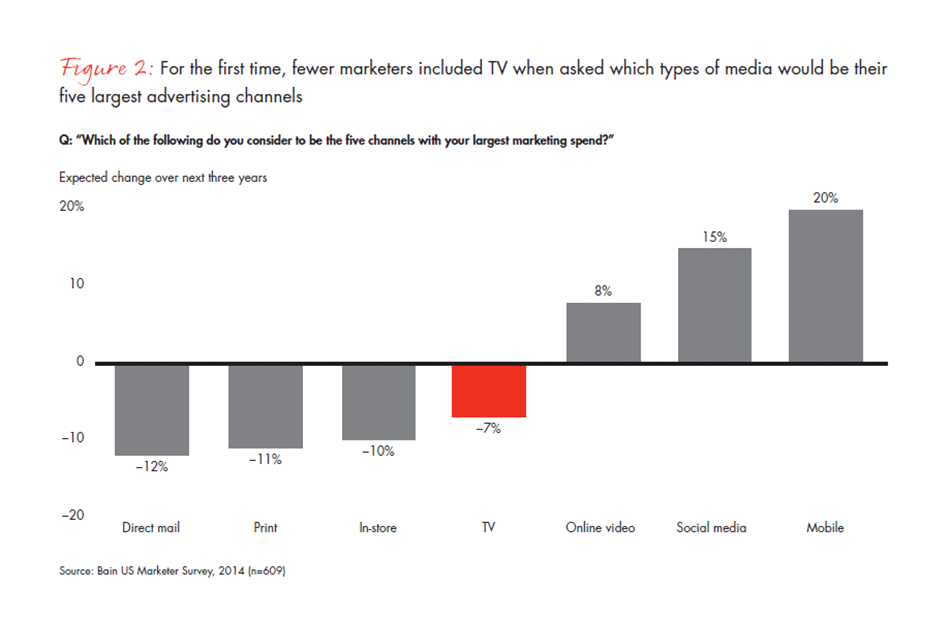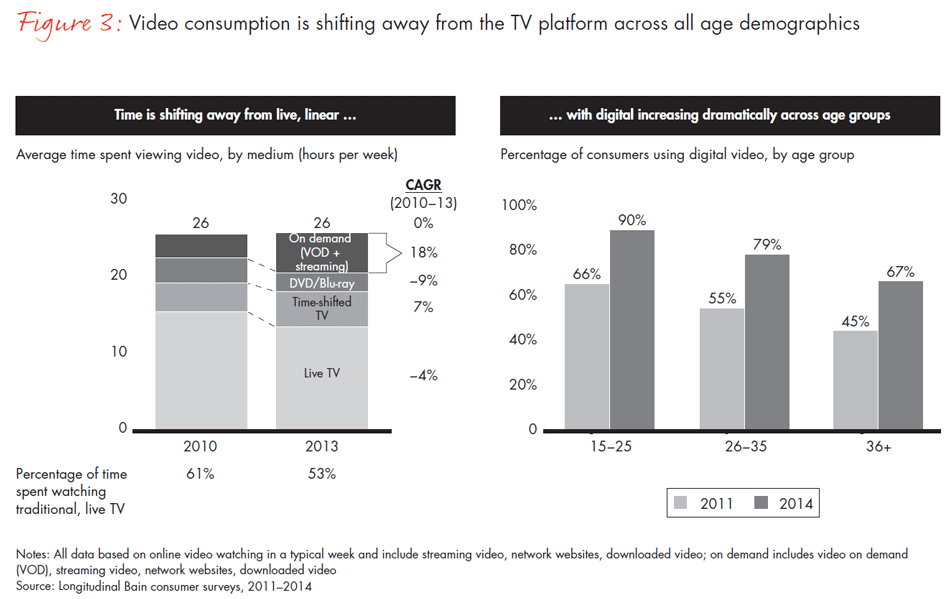Brief

Television advertising faces a critical moment of transition. Digital media and, in particular, digital video channels are becoming first options for consumers—and for marketers that increasingly expect television to deliver targeting and measurement capabilities similar to digital. Bain’s most recent research on marketing trends finds that marketers now say television performs worse than digital in the areas they care most about, including targeting, measurement and engagement (see Figure 1). Of greatest concern? Digital advertising is even challenging TV’s once unassailable area of dominance: audience reach.

This research also marks the first time we have seen a decline in TV’s appeal when we asked marketers which media comprise their five largest advertising channels (see Figure 2). Major brands are shifting ad dollars away from TV faster than most people realize. One national quick-service restaurant in the US told us that it didn’t spend any money on TV in 2014 and will spend even more on digital in 2015.

All of these indicators should worry TV executives, especially since linear TV viewership appears to be in a steady decline (see Figure 3). This is an existential threat to networks, as marketers shift their spending from TV to digital at scale while the economics of providing content through digital channels do not yet make up for lost ground in traditional TV advertising. Distributors should also be concerned because negotiations on programming fees will only intensify and the health of the entire TV ecosystem is at risk as TV advertising comes under greater pressure.

The TV industry is responding to these trends with new partnerships, data platforms and targeting tools, but we believe that TV can and should be doing more to close the gap with digital. Part of the solution lies in closing the gap with digital competitors, but part also lies in leveraging what TV does best: brand campaigns, simultaneous reach and providing the foundation for cross-platform advertising and measurement. As part of a renewed push, it could be time for content providers and distributors to put aside historical conflicts and join forces to confront the larger threat from disruptive, over-the-top digital providers. The challenge of quickly adjusting to different dynamics and forging new working relationships is large—but so is the size of the prize. If the industry acts now to evolve its ad offering and go-to-market approach, Bain estimates the opportunities in raising CPMs (cost per 1,000 impressions) and reversing outflows of ad spending could be worth $10 billion to $20 billion across the TV advertising ecosystem.
No-regrets moves
Someday, traditional TV, through the promise of addressable set-top boxes, may be able to target its ads as well as digital channels can, but that’s years away. Technical constraints and obstacles to collaboration mean that dynamic ad insertion will not reach scale in the next two to three years. Even so, networks and distributors can make some no-regrets moves to begin to capture the value at stake, and many of these actions will lay the foundation for an evolution toward converged, cross-platform buying and selling that will enable traditional TV advertising to remain competitive for years to come.
Anticipate and deliver against marketers’ rapidly changing needs. As digital advertising alternatives proliferate, marketers’ preferences about what and how to buy are shifting rapidly. It will become more important than ever for the TV industry to understand the latest marketer trends and behaviors, an area in which digital has invested heavily in recent years. Once armed with the latest proprietary marketer insights, many companies will want to transform their sales and go-to-market models so that they can start winning their fair share of battles against digital competitors—not only in sales pitches but also in public relations. Go-to-market models will likely evolve to encompass various approaches, ranging from targeted digital sales to more traditional selling of premium inventory.

How TV can compete with digital
Television advertising must accelerate its evolution to keep pace with all-digital competitors.
Generate proprietary audience insights to improve address-ability of current TV ad inventory. For networks, this means engaging with partners to build a robust data set based on viewer demographics, usage and preferences. These data partners could range from pure data and analytics providers to distributors who have access to set-top box data. For example, Time Warner’s Turner Broadcasting recently turned to Nielsen Catalina Solutions for shopper loyalty and TV viewing data to help a yogurt company target buyers with its TV ads.
More importantly, networks will need to scale up their own internal analytics capabilities dramatically so that they can generate unique and proprietary insights around their viewers. These audience insights will help networks make better use of their inventory as well as provide data that marketers increasingly demand. (For more, read the Bain Brief “Why everyone in media needs an analytics upgrade.”) Beyond analytics that improve advertising, leading digital players are also experimenting with “buy” buttons that allow viewers to purchase instantly what they see on screen—thus closing the attribution loop. The race to keep up doesn’t end.
Distributors already have access to enhanced customer data through their set-top boxes, but in most cases, they don’t use it effectively. An important first step for distributors is determining how to share this data with other players in the TV advertising ecosystem, including how to monetize it and what level of control they want to preserve. Over time, distributors can move much more explicitly into analytics and use their insights to help networks price and package their ad inventory better, instead of relying primarily on ratings agencies and third-party firms. Distributors can also begin experimenting with analytics that can close the attribution loop, an area in which all major digital players are investing heavily.
In this short video, Bain Partner Charlie Kim, who leads Bain & Company's Media practice in the Americas, discusses how television networks have a critical opportunity to adapt to market shifts, adjust their value propositions and cater to marketers' data needs.
Invest now in the next-generation television ad platform. While content providers and distributors build out their digital channels, they can also continue to develop ad-serving capabilities and real-time bidding platforms for their traditional TV advertising inventory. Some distributors, such as Comcast, are out in front, but pure-play content networks also need to develop these capabilities rapidly to stay relevant as a primary provider to the marketing ecosystem. Most networks want partners to build sufficient scale that satisfies the breadth of marketer needs. The short-term returns on these investments may be limited, but this is both a defensive move and an opportunity for the TV industry to see significant upside in the medium to long term. In particular, proximity to the convergence of digital and television media will determine winners and losers in the future. Those that make the right moves today will reap the rewards tomorrow.
Collaborate with natural allies and traditional adversaries. Networks and distributors may need to rethink their partnership strategies and consider collaborating on more issues. Previous attempts at industry collaboration—remember Canoe?—delivered mixed results, but now is the time to reengage in new partnership models, given the very real threats and opportunities the industry faces.
Networks should consider actively teaming up with other networks to pool inventory, build scale and work together to build more robust television advertising platforms—whether they build and manage them on their own or rely on third-party providers.
Distributors could also build scale by teaming up with other cable companies as well as satellite and telecom media providers. Scale through partnerships could allow smaller distributors to create larger and more sophisticated ad-serving platforms, putting them on more equal footing with the largest national players.
Networks and distributors should also consider forming partnerships together, as they begin to see the advantage of moving beyond today’s adversarial relationships to a more symbiotic collaboration that will allow them to compete more effectively with digital alternatives. Cablevision, for example, recently agreed to provide census audience data to ESPN and its parent, Walt Disney Company, which they aim to use to deliver more effective offers to advertisers. Deals such as this require strong executive leadership, willpower and very deliberate structuring. But we believe there is great upside in exploring such partnerships, and we see no winning strategies based on going it alone.
TV industry players are beginning to respond to the challenge of digital competitors with early partnerships and efforts to generate sharper insights that will allow them to target viewers more effectively and thus make better use of their content inventories. They can do more: Over the next three to five years, executives in leading companies will likely expand these trial efforts into more systematic and holistic approaches that balance short-term no-regrets moves and long-term big bets. Those that can rapidly commit to the transition, reasserting the advantages that TV holds in its content inventory, its unique capabilities and its relationship with viewers, will gain a distinct and sustained advantage over competitors.
Charlie Kim and Danny Hong are partners with Bain & Company in New York. Both work with the firm’s Global Media practice, and Charlie Kim leads the Media practice in the Americas.


